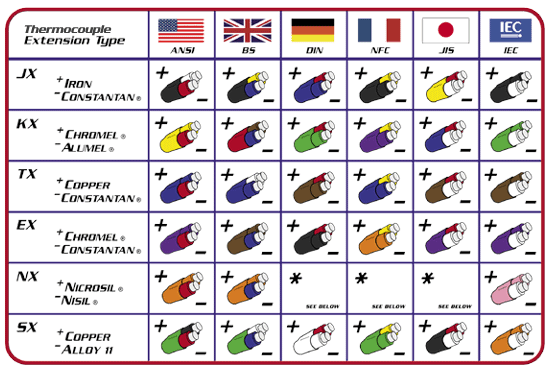Types of thermocouples
Types of Thermocouples:
Type K- Type K (chromel{90 percent nickel and 10 percent chromium}–alumel) (Alumel consisting of 95% nickel, 2% manganese, 2% aluminium and 1% silicon) is the most common general purpose thermocouple with a sensitivity of approximately 41 µV/°C, chromel positive relative to alumel. It is inexpensive, and a wide variety of probes are available in its −200 °C to +1350 °C / -328 °F to +2462 °F range. Type K was specified at a time when metallurgy was less advanced than it is today, and consequently characteristics vary considerably between samples. One of the constituent metals, nickel is magnetic; a characteristic of thermocouples made with magnetic material is that they undergo a step change in output when the magnetic material reaches its curie point (around 354 °C for type K thermocouples).
Type E- Type E (chromel–constantan)has a high output (68 µV/°C) which makes it well suited to cryogenic use. Additionally, it is non-magnetic.
Type J- Type J (iron–constantan) has a more restricted range than type K (−40 to +750 °C), but higher sensitivity of about 55 µV/°C. The Curie point of the iron (770 °C) causes an abrupt change in the characteristic, which determines the upper temperature limit.
Type N- Type N (Nicrosil–Nisil) (Nickel-Chromium-Silicon/Nickel-Silicon) thermocouples are suitable for use at high temperatures, exceeding 1200 °C, due to their stability and ability to resist high temperature oxidation. Sensitivity is about 39 µV/°C at 900 °C, slightly lower than type K. Designed to be an improved type K, it is becoming more popular.
Platinum types B, R, and S
Types B, R, and S thermocouples use platinum or a platinum–rhodium alloy for each conductor. These are among the most stable thermocouples, but have lower sensitivity than other types, approximately 10 °C. Type B, R, and S thermocouples are usually used only for high temperature measurements due to their high cost and low sensitivity.
Type B- Type B thermocouples use a platinum–rhodium alloy for each conductor. One conductor contains 30% rhodium while the other conductor contains 6% rhodium. These thermocouples are suited for use at up to 1800 °C. Type B thermocouples produce the same output at 0 °C and 42 °C, limiting their use below about 50 °C.
Type R- Type R thermocouples use a platinum–rhodium alloy containing 13% rhodium for one conductor and pure platinum for the other conductor. Type R thermocouples are used up to 1600 °C.
Type S- Type S thermocouples are constructed using one wire of 90% Platinum and 10% Rhodium (the positive or "+" wire) and a second wire of 100% platinum (the negative or "-" wire). Like type R, type S thermocouples are used up to 1600 °C. In particular, type S is used as the standard of calibration for the melting point of gold (1064.43 °C).
Type T- Type T (copper–constantan) thermocouples are suited for measurements in the −200 to 350 °C range. Often used as a differential measurement since only copper wire touches the probes. Since both conductors are non-magnetic, there is no Curie point and thus no abrupt change in characteristics. Type T thermocouples have a sensitivity of about 43 °C.
Type C- Type C (tungsten 5% rhenium– tungsten 26% rhenium) thermocouples are suited for measurements in the 0 °C to 2320 °C range. This thermocouple is well-suited for vacuum furnaces at extremely high temperatures. It must never be used in the presence of oxygen at temperatures above 260 °C.
Type M- Type M thermocouples use a nickel alloy for each wire. The positive wire contains 18% molybendum while the negative wire contains 0.8% cobalt. These thermocouples are used in vacuum furnaces for the same reasons as with type C. Upper temperature is limited to 1400 °C. It is less commonly used than other types.
Chromel-Gold/Iron- In chromel-gold/Iron thermocouples, the positive wire is chromel and the negative wire is gold with a small fraction (0.03–0.15 atom percent) of iron. It can be used for cryogenic applications (1.2–300 K and even up to 600 K). Both the sensitivity and the temperature range depends on the iron concentration. The sensitivity is typically around 15 µV/K at low temperatures and the lowest usable temperature varies between 1.2 and 4.2 K.

sales@thermometricscorp.com